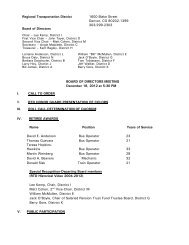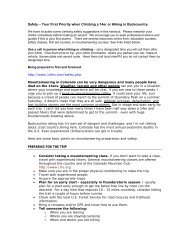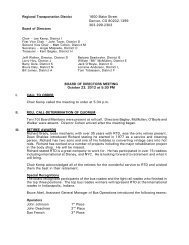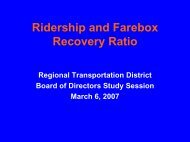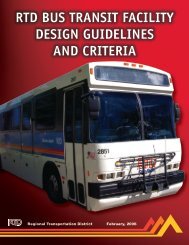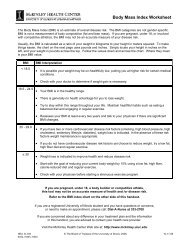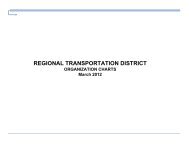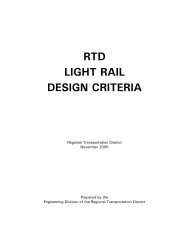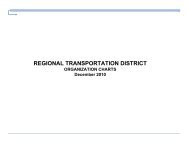Commuter Rail AC Electrification Load-Flow Simulation Report - RTD
Commuter Rail AC Electrification Load-Flow Simulation Report - RTD
Commuter Rail AC Electrification Load-Flow Simulation Report - RTD
You also want an ePaper? Increase the reach of your titles
YUMPU automatically turns print PDFs into web optimized ePapers that Google loves.
<strong>Commuter</strong> <strong>Rail</strong> <strong>AC</strong> <strong>Electrification</strong> <strong>Load</strong>-<strong>Flow</strong> <strong>Simulation</strong> <strong>Report</strong> Revision 1<br />
The actual need for such equipment can be determined by performing a follow up study<br />
evaluating the impact of traction power system loads onto the power utility system. Such study<br />
should determine busbar voltage unbalance and current unbalance in nearby generators.<br />
Further, the study should calculate individual and total harmonic distortion of voltage and<br />
current, especially in the event, that the power utility has capacitors and filters installed on the<br />
high voltage system. The results of the study should be compared with previously agreed limits<br />
and decision on any special equipment requirements made accordingly.<br />
3.3 TR<strong>AC</strong>TION POWER DISTRIBUTION SYSTEM<br />
3.3.1 Feeder/Catenary System<br />
In the autotransformer-fed system, traction power from substations is distributed to trains by the<br />
overhead autotransformer feeder and catenary systems. The substations transformers utilize a<br />
center tapped secondary winding where the autotransformer feeder system is connected to one<br />
end of the substation transformer secondary winding and the catenary system is connected to<br />
the other end of the winding through medium voltage switchgear. The secondary winding’s<br />
center tap is tied to the rail/static wire/ground power return system.<br />
For two track high-density operation, two along-track feeders, one for each track, are normally<br />
provided for redundancy in the system.<br />
3.3.2 Phase Breaks<br />
As already mentioned, the primary windings of each traction power transformer are connected<br />
to only two phases of the power utility three-phase system. In order to mitigate the utility system<br />
unbalance, the two phase connections are rotated. For example, the first transformer can be<br />
connected to phases A & B, the second to phases B & C, the third to phases C & A, and so on<br />
for each successive transformer. Rotating the transformer connections causes the secondary<br />
windings of adjacent transformers to be out-of-phase. In order to electrically separate the<br />
sections of distribution system which are operating at different phases, phase breaks are<br />
installed in the overhead catenary system at the substations and at switching stations. The<br />
autotransformer feeders are also sectioned at the locations of phase breaks by using insulators.<br />
3.3.3 Switching Stations<br />
In order to provide for the autotransformer feeder and catenary system switching in the event of<br />
substation outages, switching stations are provided between each pair of adjacent substations.<br />
To facilitate the overhead system switching operations, each switching station is equipped with<br />
medium voltage indoor switchgear or outdoor circuit breakers. The circuit breakers are<br />
configured in two sections. The autotransformer feeder section includes circuit breakers on<br />
each side of the sectionalizing point and a bus-tie circuit breaker. Similarly, the catenary section<br />
includes circuit breakers on each side of the phase break and a bus-tie circuit breaker. The<br />
autotransformer feeder and catenary circuit breakers are normally closed and the bus-tie circuit<br />
breakers are normally open. The feeder and catenary circuit breakers of each track are<br />
intended to be arranged so they operate mechanically and electrically together. The purpose of<br />
the bus-tie circuit breakers is to connect the adjacent sections of the distribution system in the<br />
event of substation outage.<br />
02/27/2009 FRSC Page 9 of 250




